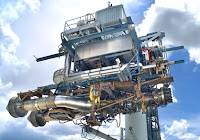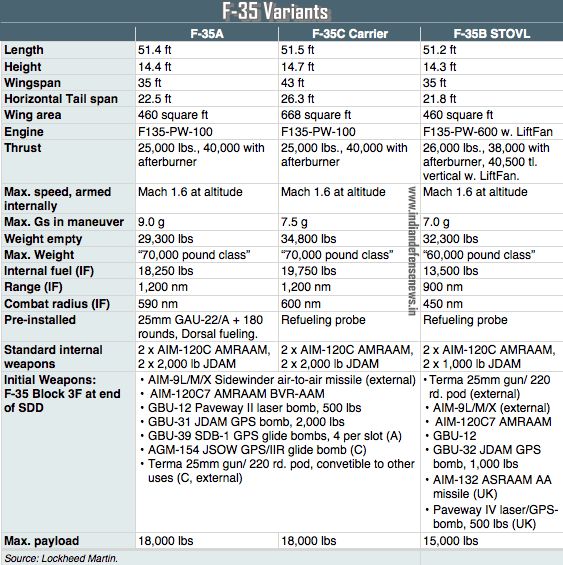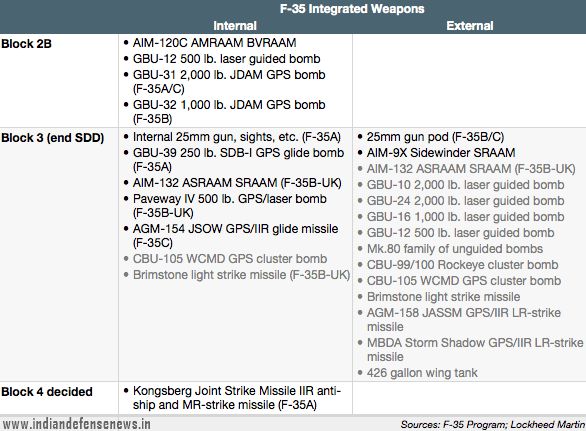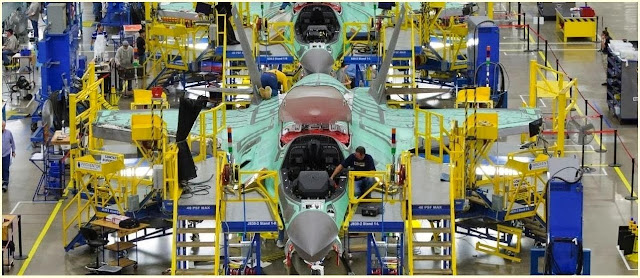http://www.indiandefensenews.in/2015/08/idn-take-why-india-should-buy-f-35.html
IDN TAKE: Why India Should Buy the F-35 Lightning II
Thursday, August 20, 2015 by Indiandefense News
INTRODUCTION
The Lockheed Martin F-35 Lightning II is a family of single-seat, single-engine, all-weather stealth multirole fighters undergoing final development and testing by the United States. The F-35 Lightning II, the world's most advanced multi-role fighter is virtually a flying computer, which is a combination of a stealth bomber and a fighter jet and it promises to be the most effective fighter aircraft in decades to come. The F-35 will be a valuable asset to any air force in its arsenal, it will also be a viable proposition in the long-run when compared to any other aircraft in the next decade or more as it is now become an unstoppable proposition. Lockheed Martin has designed and built a fighter that has blown through the boundaries of imagination.
KEY FEATURES
STEALTH: The F-35 is designed as an ‘affordable stealth’ air dominance fighter. It has exceptional abilities as a fifth generation fighter which features radar evading all aspect stealth capability, supersonic speed and extreme agility, network-enabled operations, advanced sustainment, combined with air-to-air and air-to-ground combat potential, unmatched air dominance air combat roles with the most powerful and comprehensive integrated sensor package of any fighter aircraft in history. The sensors and communications systems enable pilots to share information securely with forces at sea, in the air or on the ground for more cohesive operations. The F-35 is a fifth generation technologically sophisticated single seat, single engine aircraft, but unlike its predecessor the F-22A Raptor, it has the capability to perform
additional functions such as reconnaissance, air defense missions along with similar tasks like ground attack, interdiction and tactical strikes, electronic warfare, and signals intelligence roles.
SENSORS: The F-35 is equipped with an advanced APG-81 AESA (Active Electronically Scanned Array) Radar strong AESA advantages of simultaneous air-air and air-ground capabilities, major maintenance & availability improvements, and secure, high-bandwidth communications benefits. The F-35 also shares a “sensor fusion” design, based on an even more extensive sensor set embedded all around the airframe. F-35 has a superior infrared and ground-looking sensors.
Rockwell Collins F-35 Helmet-Mounted Display System

These sensors are connected to a lot of computing power, in order to create single-picture view that lets the pilot see everything on one big 20 inch LCD screen. As part of that sensor fusion, the F-35 will be the first plane is several decades to fly without a heads-up display. Instead, pilots will wear Elbit/Rockwell’s Joint Helmet Mounted Cueing System (JHMCS) helmet or BAE’s Helmet-Mounted Symbology System (HMSS), and have all of that information projected wherever they look. JHMCS is both a strength that adds new capabilities, like the ability to look “through” the plane’s floor, and a single point-of-failure weakness.
Pratt & Whitney F135 Engine on a Testbed
 ENGINE:
ENGINE: The F-35 was set to offer interchangeable engine options. That has been an important feature for global F-16 and F-15 customers, improving costs and performance. The Pratt & Whitney F135 powers the F-35. An alternative engine, the General Electric/Rolls-Royce F136, was being developed until it was cancelled by its manufacturers. Neither the F135 or F136 engines are designed for supercruise, the F-35 can achieve a limited supercruise of Mach 1.2 for 150 miles. The F135 is the second stealthy afterburning jet engine. Like the Pratt & Whitney F119 from which it was derived, the F135 has suffered afterburner pressure pulsations, or 'screech' at low altitude and high speed. The F-35 has a max speed of over Mach 1.6. With a max takeoff weight of 60,000 lb (27,000 kg),the Lightning II is considerably heavier than the lightweight fighters it replaces.
WEAPONS: The fighter employs several cutting-edge but uncharted technologies hence it has to undergo fifty six thousand separate tests everything from making sure a bomb will fall out of the concealed bay to seeing what happens when dropped at supersonic speeds.The F-35’s internal weapon bay gives it the ability to carry larger bombs and missiles, but the price is that F-35s can carry just 2 internal air-to-air weapons, instead of a maximum of 8 in the F-22A. As table above shows, development, testing, and software issues have also combined to give initial F-35 fleets a very narrow set of weapons. Indeed, the initial operational set that comes with Block III software has about the same weapon options as the single-role F-22A.
SOFTWARE POWER: The F-35 is laden with advanced software which runs into millions of lines code, to assist the pilot in all spheres of operations ably assisted with sophisticated avionics hardware. It comprises of more than 24 million lines of code mainly written in C and C++ and also uses ADA programming language incidentally the same language which is used in the Flight Control System of LCA Tejas. As in any complex cutting-edge software-technology development, the program has faced some production and implementation setbacks. As per the 2013 Annual Report of the Pentagon’s Director of Operational Test and Evaluation (DOT'&'E) the F-35’s software development is falling behind schedule, and beginning to seriously threaten the Marine Corps and Air Force plans to declare “initial operational capability” in 2015 and 2016 respectively.
The F-35 runs on DO-178B securely partitioned, safety-critical, certified real-time operating system (RTOS).
The F-35 is also equipped with Autonomic Logistics Information System (ALIS), which determines whether the plane is safe to fly or not.
The F-35 “power-by-wire” system represents advancement on the more electric aircraft topology integrating:
>>Self-contained electro-hydrostatic (EHA) actuators to position primary flight surfaces
>>Electronic Control Units to remotely drive and control the EHAs
>>Electrically driven Power-Driven-Units (PDU) to position the maneuvering leading edge flaps
The F-35 Lockheed Martin fighter aircraft has recently surpassed 15,000 cumulative hours of flying marking a major milestone for the program. “Flying 15,000 hours itself demonstrates that the program is maturing, but what I think is even more impressive is the fact that operational F-35 accounted for more than half of those flight hours,” said J.D. McFarlan, Lockheed Martin Vice President for F-35 Test and Verification.
F-35 VARIANTS AND COST STRUCTURE
F-35 BF-03 Short Take Off Vertical Landing Version
The F-35 is a tri-variant family, the F-35A is a conventional take off and landing aircraft (CTOL), the F-35B is a short take-off and vertical-landing variant (STVOL), and the F-35C is a carrier-based variant (CV). However, there have been allegations of considerable delays in its development cycles, prohibitive cost and time escalations and several technological complexities such as compromised "extreme plus agility" that are yet to be resolved. There are arguments against the fighter that the use of stealth technology has increasingly offset the F-35's payload capacity and range and the stealth technology in and of itself and would negate its primary role as a stealth aircraft with advances in Radar and Infrared detection technologies.

There have been also many wild speculations about F-35’s price tag since it is the world’s most expensive military weapons program. Lockheed Martin now projects that if production ramps up, the fighter will match the cost of a current F-16 in inflation-adjusted dollars. It also claims that the unit cost expected for the F-35A is around $85 million in 2019 (which would be far cheaper than Dassault Rafale). However, the Senate Armed Services Committees and the National Defense Authorization Act (NDAA) estimated the total unit cost for the cheapest version, which is the F-35A, is around $172.7 million per aircraft, certainly a dreadful factor for all concerned.
ANALYSIS
Now that we have learnt a little about the F-35, let us explore how we can accommodate and integrate this amazing state-of-the-art fighter into the Indian Air Force (IAF). Traditionally, India has always opted for Russian military hardware especially when it comes to fighter jets and the only deviancy made has been acquiring the French Mirage-2000 and the Anglo/French SEPECAT Jaguar. Over the decades, the Indo-Russo diplomatic relationship has stood the test of time particularly well even after the fall of the Soviet Union except on a few contentious issues.
COUNTER ARGUMENT
Several Indian critics have argued that the F-35 is not an ideal choice for India based on the following contentions:
Firstly we already have an ongoing program with the Russians to develop a Fifth Generation Fighter Aircraft (FGFA)
Secondly the F-35 is still in developmental phase and yet to see the production floor
Thirdly is its prohibitive cost of ownership and
Finally, and the lamest of the lot is that India will not gain any industrial or technological accruals since there will be no licence production involved. (Disputation based on an article published by Institute for Defence Studies and Analyses)
Let us examine each point in detail:
Firstly, if we go ahead with the FGFA proposal as envisaged, we have to factor in the perceivable cost escalations due to inordinate delays mainly owing to our notorious bureaucratic processes, red tape impediments, dithery, inept and callous decision makers and Russia's reluctance to transfer crucial technologies. Our relationship with the Russians is also patchy these days now that the pugilistic fervors is more pronounced and sporadic. Russia is also looking at Pakistan as a steadfast defence partner.
The serviceability of the Su-30MKI front line fighter has been affected due to the lack of repair and overhaul facilities that Russia had agreed to set up but has not done so far. There has also been incessant negative reporting by the media, which claims that Russia is not fulfilling its obligations under the FGFA program.
Another prime drawback is our passiveness and lethargy to absorb technology. It is also evident now that HAL will not be associated in the co-development or co-design of FGFA and in the end would be just involved in the customization process similar to their involvement in the Su-30MKI project. We have to bear in mind the Russians have progressed briskly on the PAK-FA project for any meaningful technological sharing that HAL can now hope. As per latest estimates, the FGFA project will finally cost both India and Russia $12 billion with India bearing half of it, and as per Lockheed, the F-35A will cost around $85 million or less in 2019. Assuming it stays around the $75 to $80 million mark per aircraft during 2019, India can then purchase around 80- 85 fighters out of India’s share of $6 billion for the FGFA project. Therefore, I presume, going forward we stand to gain nothing commercially or politically out of this partnership except earn the goodwill of the Russians. Eventually the final cost of FGFA project will match or even exceed the purchase cost of the F-35A but with this proviso that the US government subsidizes the purchase as the cost levels would be way beyond our fiscal reach.
Secondly, despite what detractors say the F-35 program is very much on track since it has completed several extended, rigorous and complicated tests, set major milestones, progressively validated respective performance parameters, delivered more than 100 jets to various users that include the first five international deliveries. Recently, South Korea has selected to buy F-35 CTOL variant as its next-generation fighter, South Korea becomes the third foreign customer to buy the F-35, joining Israel and Japan. The fighter is flying on a daily basis verifying aerodynamics and mission performances, fixing software bugs, performing protracted mid-air refueling exercises, conducting night flights, live fire and targeted weapons testing, carrier trials and VSTOL performance testing.
Thirdly, the F-35 is a truly global program consisting of international partners ensuring interoperability not only with the three US services but also with other participating countries. The production involves leading international aerospace companies like Lockheed Martin, Northrop Grumman, Pratt '&' Whitney and BAE Systems. Lockheed Martin is the principal contractor. The program provides significant job opportunities for both the domestic and international entities and it promotes industrial competitiveness and provides substantial technology benefits. Suppliers in all the partner countries are producing F-35 components for all the three variants.
The global nature of the program results in significant cost savings, the cost of the F-35 will be comparably low once economies of scale sets in since the Pentagon has committed to buy more than 2,400 fighters. Moreover, there has been undue delays in the procurement of Rafale which has escalated costs exponentially, and as per agency reports the defense ministry had envisaged a budget of about Rs. 42,000 crore in 2007 for buying 126 fighter aircraft. But (hold your breath here) the cost in 2014 could go up as high as Rs 100,000 crore, with each Rafale costing about Rs 590 crore. This means the Government will have to find additional funds since the defense budget has seen only a modest growth of 5 per cent each year.
Building the F-35’s at Lockheed Martin Corporation
Lastly, the argument that India does not achieve any industrial or technological benefits by purchasing the F-35 is a daub. To controvert this justification, we have to retrospect to the so-called technology transfer programs that HAL is involved with the various foreign defense partners over the past few decades. It is evident that nothing significant has accrued out of this arrangement either by HAL or by other defense agencies. Some of the significant Transfer of Technology/Licence Production/ Joint Ventures platforms is the SEPECAT Jaguar, Mig-29, Sukhoi-30MKI and the Mirage-2000. Despite several decades of manufacturing these fighter jets in India, we have not been able to leverage the surmisable knowledge and experience thence gained. The LCA-Tejas has taken close to two decades to evolve as a credible fighting system and it is still limping toward its crucial Final Operational Clearance (FOC), the lumbering KAVERI engine development has also not accomplished its objectives, and let us not forget the IJT-SITARA/NAL SARAS/HTT-40 fiascoes also in the bargain.
Since off late “Offset” provisioning has become a de jure part of the defense procurement policy constituted by Ministry of Defense, although some dilution has already been initiated by the government, a detailed analysis is required to assert the extend of leverage it lends to the overseas vendors. Therefore, it becomes imperative to understand what a TOT arrangement is as against an Offset obligation. Offset obligates the arms seller to reinvest arms sales proceeds in the purchasing country. Transfer of Technology on the other hand is assignment of technological intellectual property, developed and generated in one entity, to another through legal means such as technology licensing or franchising. Hence, in general, the difference in scope is insignificant between these agreements and regretfully none of our defense agencies has gained any substantial strategic advantage or exploited the opportunity to absorb technologies, as notably China has been able to achieve in the past few decades.
LCA TEJAS EMBROILMENT: The Tejas will not see active service for a minimum of seven years or more and the FGFA for well over a decade, given the pace at which the negotiations are heading, additionally the MMRCA deal with Dassault is also going through an unpredictable tumble. In the interim, the F-35 can provide total air dominance '&' superiority over our airspace as a stopgap arrangement, the F-35 can thus smoothly transition as a substitute for Rafale by following a similar delivery schedule as defined in the MMRCA deal. Buying the F-35’s outright from Lockheed Martin Corporation with no preconditions from them will enable the government to eschew the myriad and cockeyed offset regulations and other related contractual obligations attached to such a deal and it is also apparent foreign investors are rather dicey about it. Shedding the mental apartheid perceptibly demonstrated by our politicians, bureaucrats, analysts and writers especially when it comes to having any defense dealings with the Americans would not only have considerable and tangible benefits for IAF but also for the other armed services as well.
EXIGENCY PLANS
Hence, the most suited and prudent course of action the government should undertake is:
1. Scrap the Medium Multi-Role Combat Aircraft (MMRCA) deal in its entirety (This is a tough call since France has stood by India during tough times). Thankfully, this has since been achieved.
2. Scrap the nascent FGFA program before it becomes a typical public sector nightmare, though the PAK-FA on which it will be generically based on by itself is a highly advanced, extremely agile and low observable signature aircraft with surprisingly superior capabilities.
3. Buying the F-35 will bring cutting-edge technology to the battlefield" as IAF's "backbone" for 50 years. It will clearly be the most survivable tactical aircraft we've ever fielded. Therefore, an outright purchase should be planned with all other conditions included except Offset obligation.
4. Promote and optimize AMCA (Advanced Medium Combat Aircraft) as an indigenous alternative to FGFA, strive to exceed or at best match or assimilate the technical and tactical superiority benchmarks of F-35/PAK-FA by providing sizable funds, infrastructure, human resources, and government administrative support. This approach is absolutely necessary for our military goals.
5. Elevate the Tejas program as an exigent National Security initiative, augment further funding, human resources, infrastructure, and accord unconditional organisational support. Strive to realign Tejas as a deputized MMRCA.
6. Formulate exhaustive and unconditional contract control policies (US government & Lockheed Martin are bound to comply since the aircraft has gone over budget, a block of around 100 aircraft will send good cheer to the program) before embarking on the purchase of F-35’s thus obviating future commercial, technical and logistical conundrums such as total immunity assurance against impromptu sanctions, establishment of spare parts bank, price protection stipulation based on "complete-full-package" deal to ensure the projected price includes the aircraft, avionics, mission systems, and the engine, optimal maintenance training procedures, access to software codes, coalesce comprehensive risks mitigation policy to address risks identification, planning, analysis, management, monitoring and control methodologies etc.,
7. Mitigate conflict between probity and speed in defense equipment acquisitions
8. Lastly, India urgently needs to reform its armed forces reporting structure and should adapt the US model of having a Chairman, Joint Chiefs of Staff and a subset of theater commanders as the nature of future wars imposes the need for an overall commander to formulate strategies and coordinate overall military operations. This structure will largely help in preventing corruption, cronyism, nepotism, indiscipline and inefficiency.
CONCLUSION
Finally, if India goes ahead with the F-35A plucky deal it will be assuredly a winning proposition on all fronts and it will be foolhardy if it does not. The F-35 will have a future. The F-35 would be an essential component to any future conflict with an adversary. High-intensity combat against a peer competitor opponent, or into the teeth of an advanced anti-access/area denial system, may not occur within the lifetime of the airframe. But if the opportunity comes to demonstrate the F-35’s quality, the result could very well be magnificent.
The limited purchase of 70 to 80 aircraft on account of fiscal prudence or constraints would sacrifice force structure but it will however deepen India's strategic depth, act as a force multiplier, effectively meet the aggressive operational challenges because of its technological lead over existing stealth fighter programs in and around the Indian subcontinent. It is important to note that both Russia and France have been strong allies of India in the past and our relationship goes well beyond mere immediate lolly. The tough measures quoted above are the dire need to strengthen India's future as a bulwark of current and future international multipolar political order.
Washington for many Indians cannot be trusted and it is in America’s interest to backpedal the waning diffidence that this Obama administration has tardily percolated, especially if it wants to project India as a containment component to China. China is going gung ho over the South China Sea region. It has also been belligerent in the recent past especially condoning the North Korean regime by providing them with weapons and sensitive technology, it has been an overt proliferator of nuclear weapons and technology, especially to India and America’s immediate adversaries Pakistan, Syria and Iran. China has been browbeating, grandstanding, posturing and blustering its neighbors including India in the recent past.
India is a strong democratic country which will play a crucial role in the near future since it occupies an all-important Geo-strategic location between China and the Middle East. The emergence of India as a blue water naval power needs to be accredited and bucked up by the Americans as a powerful ally who will play a crucial role in the Persian Gulf shipping corridor. India’s enunciation of Russian action in Crimea despite its unwarranted belligerence should be a grim reminder to America that it will not play ball unless it is treated on par with its other NATO allies and cannot be treated just as a ephemeral mollifying adornment. How the US aligns itself from here on (since a strong and stable government is in place now under the mollifying stewardship of Narendra Modi) would have enormous ramifications for these two democratic superpowers for the future. Strengthening bilateral and military relationships between the two superpowers will provide ample room for a stable and strong global order.
(
This article has been adapted from one of IDN's associated blog)
Admin - IDN




 ..
..








